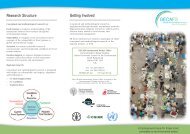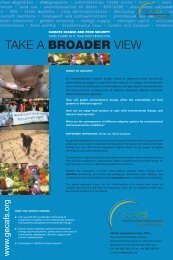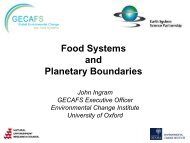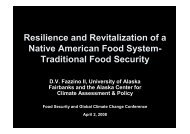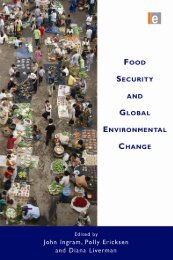From Food Production to Food Security - Global Environmental ...
From Food Production to Food Security - Global Environmental ...
From Food Production to Food Security - Global Environmental ...
- No tags were found...
You also want an ePaper? Increase the reach of your titles
YUMPU automatically turns print PDFs into web optimized ePapers that Google loves.
determine interactions along and between scales, and understanding the interactions betweenand within them are critical <strong>to</strong> understanding the controls on food security.Recognising that an analysis of existing approaches and strategies for food security atregional levels was lacking (Liverman and Ingram, 2010: Paper 4), GECAFS developmenttherefore concentrated on how <strong>to</strong> integrate environmental and socio-economic drivers andoutcomes at this spatial level. The specific GEC angle led <strong>to</strong> considerations of whatadaptation measures could enhance food security by reducing food system vulnerability <strong>to</strong>GEC at regional level, while also minimising further environmental degradation. Manytechnical considerations apply at local level, especially concerning producing food (e.g.enhanced agro- and aquaculture technologies), while others pertain <strong>to</strong> the regional level (e.g.rail infrastructure in relation <strong>to</strong> food distribution). Much of the debate at the regional level ishowever in the policy arena. This led first <strong>to</strong> issues of who was the intended policy ‘client’for outputs from such research at this spatial level; and second <strong>to</strong> the question of how best <strong>to</strong>engage them in co-designing the research agenda so as <strong>to</strong> ensure the research outputs wouldbe of most value <strong>to</strong> them (Ingram et al., 2010: Paper 5). Given the lack of regional-levelstudies (in relation <strong>to</strong> global and local), this focus opened up novel ways of formulatingGEC/food security research.As understanding grew about how the whole food system operates (as opposed <strong>to</strong> theagricultural component alone), it became increasingly clear that numerous ac<strong>to</strong>rs operateacross a wide range of scales and levels. Further, the role of ‘non-state ac<strong>to</strong>rs’ is becomingincreasingly important worldwide (Schilpzand et al., 2010) and the need for engaging thesestakeholders (i.e. beyond the research and regional policy communities) became apparent.The challenge is how <strong>to</strong> integrate these various considerations when undertaking GEC-foodsecurity research at regional level (Ingram and Izac, 2010: Paper 6).Specific challenges the thesis addresses (thesis questions)Much progress had been made in conceptualising the GEC-food security issues and researchagenda during intensive GECAFS planning exercises. However, turning these ideas in<strong>to</strong>practice posed a number of major challenges the GEC research community had thus far notexperienced, especially as it encompassed a number of food system activities beyondproducing food. These related <strong>to</strong> issues such as which disciplines should be involved and howshould interdisciplinary research best be developed; what the optimum spatial and temporalresolutions should be, and who should be involved in research design, when and how;identifying the ‘client’, and how interactions with them should best be managed; and,importantly, how research would best build on – and contribute <strong>to</strong> – improving understandingof GEC-food security interactions. Embarking on the full system approach thereforenecessitated a somewhat different approach <strong>to</strong> designing and implementing internationalGEC research projects than those which had hither<strong>to</strong> been designed by researchers on moredisciplinary <strong>to</strong>pics (Ingram et al., 2007b).8



